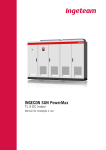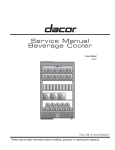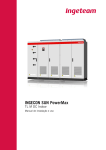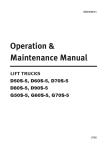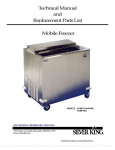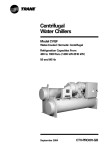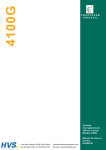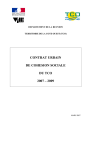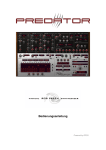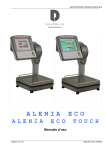Download KORG EX-8000
Transcript
PROGRAMMABLE POLYPHONIC SYNiHE MODULE OWNER’S MANUAL KORG FEATURES OF THE KORG EX-8000 1 The EX-8000 is a 2U sized rackmountable 8-voice Polyphonrc Synthesizer Module, with a built-in Digital Waveform Generator System (D.W.G.S.). The DWGS has sixteen digitally encoded waveforms stored in four 256 kilobit ROM chips. These waveforms are digitally encoded samples of actual acoustic instru. merits‘ recreated by additive synthesis techniques to enable more realistic sound synthesis: (The sixteen waveforms also include simple sawtooth and pulse waveforms such as “ I’Y , l-7 ” and “ TL ” which are found in conventional analog synthesizers.) The EX-8000 is 2U-sized so it’s rackmountable. It saves valuable space and provides a wide range of sound synthesis possibilities when used in conjunction with your MIDI synthesizer. Thank you and congratulations on your choice of the KORG EX-8000 Polyphonic Synthe Module. To obtain optimum performance, please read this manual carefully before using this synthesizer. Uses two Digital Oscillators, analog noise generator, and VCF and VCA modules for sound synthesis. You can enjoy the uniqueness of digital sound plus quick and logical sound synthesis as in analog control. 3 4 The EX-8000 accepts Initial Touch (key velocity) and After Touch (channel pressure) data, so real-time control of output volume, timbre and pitch modulation is at your fingertips when used with a synthesizer featuring these functions. 5 A programmable digital delay is included to store clear stereo effects (Chorus, Doubling, Short Delay, and Long Delay) for each of 64 tone colors in the programmer. 6 7 Auto Bend is included for more realistic synthesis of human voice and brass sounds. Key Assign mode provides two polyphonic modes and two unison modes, which are effective for playing solo or bass parts or using Portamento. 8 9 Built-in Portamento produces a gradual change in pitch from one note to another. The Key Window function limits the area on the keyboard which one EX8000 controls, from one point on the keyboard to another. IMPORTANT SAFETY PRECAUTIONS I LOCATION To avoid malfunction do not use this unit in the following locations for long periods of time: 0 In direct sunlight. 0 Exposed to extremes of temperature or humidity. 0 In sandy or dusty places. n POWER SUPPLY 0 Use only with rated AC voltage. If you will be using this unit in a country having a different voltage, be sure to obtain the proper transformer to convert to rated voltage. l To help prevent noise and degraded sound quality, avoid using the same outlet as other equipment or branching off extension cords shared by other equipment. llNPUT/OUTPUT JACKS AND CONNECTION CORDS Be sure to use standard “guitar” cables with phone plugs, such as the cable supplied with this instrument, for input and output connections to the rear panel of the EX-8000. Never insert any other kind of plug into these jacks. n Preventing ELECTRICAL INTERFERENCE As a microprocessor based device, the EX-8000 is extremely flexible in operation, yet may possibly perform erratically if exposed to electrical interference from other electrical devices and fluorescent lamps. Avoid operating the EX-8000 near possible sources of interference. If something seems to be wrong, try turning off the power, waiting about ten seconds, them turning it back on. This resets the computer circuits to their initial state so performance should return to normal. n HANDLE GENTLY Knobs and switches are designed to provide positive operation with a light touch. Excessive force may cause damage. n MAINTENANCE Wipe the exterior with a soft, dry cloth. Never use,paint thinner, benzene or other solvents. l KEEP THIS MANUAL Store this manual in a safe place for future reference. n MEMORY BACKUP l To protect your programmed memory contents, the EX-8000 utilizes a built-in rechargeable backup battery power supply. Battery life is rated at five years or more, so replacement is recommended after five years. Contact your Korg dealer or authorized service center at that time. OFor maximum security, save your sound programs on tape, using the built-in tape interface system. Then if memory contents are accidentally erased or altered, you can simply load the data back into EX-8000 internal memory in seconds! -4 CONTENTS FEATURES & FUNCTIONS 6 6 IFRONTPANEL 2 REAR PANEL/BASIC SETUP a SELECTING PROGRAMS 10 10 10 1 PROGRAM NUMBERS 2HOWTOSELECTAPROGRAMNUMBER BASIC OPERATION 12 12 12 14 1PARAMETERSANDVALUES 2HOWTOEDlTVALUES 3TUNlNG PROCEDURE MIDI 1 MIDI PARAMETERS 2KEYWlNDOW 3TRANSMITTED/RECEIVED MIDIDATAANDINDICATORS 4 MIDIJACKS CREATING SOUNDS 1FEATURESANDFUNCTlONSFORCONTROL 2SAVlNGPROGRAMDATAONTAPE 3VERlFYPROCEDURE 4LOADPROCEDURE 5TAPElNTERFACEPRECAUTlONS .) :' 21 21 21 40 1SOUNDSYNTHESlSTECHNlQUES 2PARAMETERSSTOREDINMEMORY 3WRlTlNGPROGRAMSTOMEMORY TAPE INTERFACE 15 15 16 19 20 . * MIDI IMPLEMENTATION 1TRANSMlTTEDDATA 2 RECOGNIZED RECEIVE DATA 3COMMUNlCATlONBETWEEN EX-8000ANDOTHEREQUlPMENT 4 EXAMPLES OFSYSTEM EXCLUSIVE MESSAGES USED IN COMMUNICATING WITH OTHER EQUIPMENT 5 EX-8000 BIT MAP RACK-MOUNTING THE EX-8000 SPECIFICATIONS & OPTIONS ’ 43 43 44 46 48 50 51 51 54 56 61 65 69 70 F- FEATURES AND FUNCTIONS 1. Front Panel Tune Tape Interface Jack (lkgh/Low Switch) Volume Phones Tone Switch Key Assign (Poly 1: Poly 2: Unison 1: Unison 2) Tape Switch Write Switch Program Switch Program Write Key -6 1 FEATURES&FUNCTIONS Parameter List MIDI Indicator Indicators Program No. Parameter No. Value Power Switch Value (Up/Down) Number Select Buttons l-8 Parameter Switch Bank Hold Switch FEATURES & FUNCTIONS 1 .Rear Panel/Basic Setup AC Cord Receptacle I MODEL EX-6000 UUL AC 1OOV 50/60Hz 6W lllllllllllllllllllllllll I AC cord FEATURES 81 FUNCTIONS MIDI Terminals: IN, OUT, THRU OUTPUT fLow/High Switch, Left/Mono, kight) - 0 TO RAlN OR MOISTURE SELECTING PROGRAMS This explains how to select any of the 64 different sounds stored in the EX-8000’s memory. The PROGRAMMEl section on the front panel is used for this purpose. 1P rogram Numbers n The EX-8000 can be store up to 64 different sound programs in its” internal memory. Each of these programs has a number from 11 through 88 (the digits 0 and 9 are not used). When you want to store a sound, you must assign it a program number. When you want to recall that sound, you select it by the same program number. Writing programs ,____----__--___-___-~ I - ----- - --------------- ~ I ; - - - - ----__--c-_- ---_____--_____ - - - - - ----_ - ------ _I 2.Hovv to Select a Program Number q Features and Functions for Control 4 When this switch is activated (and its LED indicator is on), different programs may be selected using the NUMBER keys. Press these keys to specify program numbers, which range from 11 through 88. Programs are arranged in eight “banks,” signified by the left digit, with eight programs per bank, signified by the right digit; 8 x 8 = 64 total programs. This holds the left “bank” digit so that you can use single number keys to quickly access any of the eight program numbers within a single bank. I 1 Shows selected program number. I 3 I 2 SELECTING PROGRAMS q How to Select a Program Number PROGRAM m fyi; sure the PROGRAM switch is set to ON. (LED Q Press the NUMBER keys to select any program number (11 - 88). p+-.---LEDIS ON Example: To select program number... . ‘,,V . , 3 Press LOAD --. * A dash aooears in the right hand digit until you select the second digit. (This means it is waiting for you to select the second digit.) m How to Select Bank Hold q ..* . . , BANK HOLD Pressing the BANK HOLD switch preserves the left digit of the selected program number. An LED dot lights up to indicate that the bank number (2) will not change. q Now if you press any of the NUMBER keys, only the right digit will change. o Only this digit changes when you press the number keys. q When you want to change to a program number in a different bank, press the BANK HOLD switch again to cancel BANK HOLD. You can now enter both digits using the NUMBER keys. [LED d m BANK HOLD Now press The LED dot goes out when BANK HOLD is off. t lights. . Parameters and Values The various aspects of a sound, such as its pitch, timbre and variations in volume, are called “Parameters”. To create or change a sound, you adjust the values of each of these parameters. On the EX-8000, there are 49 parameters per program; each parameter has a number, and each parameter’s value is also represented by a number. These numbers are shown on the front panel display. To create or change a sound, you select parameters and change (or “Edit”) their values. When the EX-8000 stores a sound in memory or calls it back from memory, it is actually storing and recalling the values you have given it for the sound’s various parameters. All possible parameters and values are listed in the “parameter index” chart on the right side of the EX-8000 front panel. To create or change a sound, you first use the number keys to select a parameter number, then you use the edit slider and up/down keys to change its value. Parameters for oscillator 1 OSCl 16’ 8’ 4’ 12 WAVEFORM Value range: 1 16 .How to Edit Values q Features and Functions for Control Shows selected parameter number. Shows current VALUE for selected parameter. This holds the Parameter Number’s left digit, so that the NUMBER keys can be used to select only the right digit. This can speed up Parameter Number selection when you are working on several parameters within the same “family” (that is, having the same left digit). When this switch is on, you can create and modify sounds by selecting different parameters (using the NUMBER keys) and varying their VALUES (using the EDIT slider and/or DOWN/UP buttons). These keys are used to select different Parameter Numbers (when the parameter switch is on). Permits rapid and easy adjustment of parameter VALUES (aspects of the sound) over a wide range. Press to change parameter values up or down a step at a time. q How to Edit Values 0 Press the PARAMETER switch so that its LED lights up. PARAMETERS @I Refer to the parameter index chart to find the number of the parameter that you want to change. Press the number keys to select the desired parameter. Example: Selecting VCF CUTOFF frequency.... This is parameter number 31, so.... p+-LEO is on 3 A dash in the right 1 Press TAPE) SAVE . When the BANK HOLD switch is pressed, the left digit is locked; then, you can change the right digit by using the NUMBER keys. q Use the Edit control or Up/Down buttons to change the parameter’s value. Suggestion: Use the Edit to make large changes in value, then use the Up/Down keys to “fine tune” the sound. (VALUE display) I VALUE EDITOR I The LED dot in the corner of the VALUE display indicates that the value of the currently selected parameter has been changed. The dot goes out if the return to its original value. ~ DOWN If you want to return to the original value of a parameter, just press both UP/DOWN keys at the same time. v press 0 Repeat steps Band Ofor each parameter that needs to be changed. To store your new sounds in memory, follow the operation procedures described in “WRITING PROGRAMS TO MEMORY” on page 40. UP A :;;!I’;:-‘; m simultaneously. m BASIC OPERATION $.Tuning Procedure q Features and Functions for Control I TUNE This controls the EX-8000’s tuning. Turning it to their right raises the pitch, and turning it left lowers pitch. 1 I b Pushing this key causes the EX-8000 to produce an A4 tone. This is the same as playing a 4th octave A note on the master keyboard. (A standard 440Hz tone will not be produced.) q Tuning the EX-8000 0 Push the Tone Key. The EX-8000 will produce an A4 tone. (Be sure that volume control is not at “0” as the tone will not be audible in this case.) l Tune to other instruments or to “A” on a strobe tuner by turning Tuning Control while holding down Tone Key. @Tone will stop when Tone Key is released. tI A4 2 MIDI 1 .MIDI Parameters The EX-8000 operates according to MIDI data transmitted from external sources. In order to receive this external data, it is necessary to make sure that the EX-8000 Receive channel is the same as the transmitting channel. It is also necessary to set the EX-8000’s Key Window function. If this is not done correctly, proper operation will be impossible. Care must be taken in setting MIDI-related parameters. The following parameters are MIDI-related. q CH (DATA RECEIVE CHANNEL) This parameter is used to select a channel for data receive. At power-ON, the data receive channel is set for that previously selected. __ VALUE DATA RECEIVE CHANNEL CH-1 : I : !5 q 1 I I CH-16 ENA (Kind of Data Received) This selects which kinds of received MIDI data the EX-8000 will receive. At value 1 (NOTE DATA), the EX-8000 receives only “note data.” At value 2 (All), it receives all MIDI data specified in the EX-8000 MIDI specifications (implementation notes.) For example, if you don’t want program numbers to be changed by some external device through MIDI, then set this value to 1. The most recently selected ENABLE value is retained when power is turned on and off. VALUE Kind of Data Received : (NOTE DATA) NOTE ON/NOTE OFF 1: VW All data MIDI li!ill OMNI When Omni is turned on, previous data is stored in the memory. However, Omni mode can also be turned on and off from the controlling (sending) device. When Omni mode is off, then the EX-8000 receives MIDI data sent only on the MIDI channel specified by parameter 84. The most recently selected Omni Mode value is retained when power is turned on and off. VALUE OMNI MODE 2 OFF ON : l.Key Window The EX-8000’s pitch range is shown below. At maximum, this range is Cl-C8. The Key Window Function limits the areas on the keyboard which one EX-8000 controls, from one point on the keyboard to another. fl Example of Key Window EX-8000 (B) controls this range n In this example, multiple EX-8000s are used. This is an example of keyboard splitting. By changing the sound parameters of each EX-8000, sound utilization possibilities are expanded, and can be controlled by one master keyboard. C8 H When one EX-8000 is used in conjunction with a MIDI synthesizer, EX-8000 sounds (for example Bass sounds) can be added on to the synthesizer’s own sounds, within the range on the keyboard controlled by the EX-8000. MIDI 8 Parameters Related to Key Window (These 2 parameters are not displayed on panel.) , q KEY WINDOW BOTTOM ’ POINT VALUE This parameter sets the low-end range. This can be set in half-steps. The most recently selected point’s value is retained when power is turned on and off. Note: When the Key Window Bottom is set to Cl, notes lower than note 23 will be registered as the same note in octave 24-35. q KEY WINDOW TOP This parameter sets the high-end range. This can be set in half-steps. The most recently selected point’s value is retained when power is turned on and off. VALUE I POINT High C I Note: When the Key Window Top is set to CB, notes higher than note 1013 will be registered as the same note in octave 97-108. n When the values of parameters 87 and 88 are changed by half-steps, the sharps (1) are shown by a decimal point on the display: Cl - C.l - dl - d.1 Flats ( b ) are not shown. When editing, value can be approximated by using the Edit Control (Edit Control changes notes in major thirds-Cl -El -G # 1 -C2), and set exactly by pushing the Up/Down keys. MIDI Eil Relationship Between Key Bottom and Key Top These parameters can be set anywhere throughout the 85 notes on the keyboard, however there are 2 particular relationships which are possible. H When Key Bottom is set lower than Key Top. Plays these notes n When Key Boltom is se! higher than Key Top. Plays these notes * However, when this setting is used, note data other than that set in EX-BOO0 is cancelled even if it is received. MIDI 3 .Transmitted/Received MIDI Data and MIDI Indicators 0 Received MIDI Data W Note OFF n Note ON n Control change: No. 1 OSC modulation No. 2 VCF modulation No. 7 Vdlume No. 64 Damper pedal on/off No. 65 Portamento on/off H Program change n Channel pressure (After Touch) W Pitch bender change n All notes OFF n Omni MODE OFF n Omni MODE ON n Active sensing H System exclusive information q Transmitted MIDI Data n Program Change Wystem Exclusive Messages q MIDI indicator The MIDI indicator lights when the above MIDI data is received. When it is not properly received the indicat or does not light, so verification is simple. MIDI 4.MIDI Jacks Rear Panel MIDI D Receives MIDI data. MIDI OUT is used only when transmitting internal MIDI data to external MIDI equipment, so it is not normally used. (Does not transmit program change data, etc.) THRU I MIDI, THRU OUT I MIDI OUT Resetting MIDI If the EX-8000 is being used in a MIDI connected system and starts producing erratic results (making a continuous sound, going out of tune, producing erratic modulation, etc.) press the front panel WRITE key. This resets the circuitry. However, if the write switch is set to ENABLE, the WRITE made is effected. Push the WRITE key after setting to DISABLE. I MIDI IN i Retransmits unchanged MIDI data received through the MIDI IN Jack. q IN WRITE Press CREATING SOUNDS 1 .~ound Synthesis Techniques To create new sounds on the EX-8000, you change or edit old programs. You do not start with a “blank slate”. There are 64 sounds already in memory. If you have a new sound in mind, the easiest approach is to first select a sound that resembles the sound you want to create. Then “edit” (change the selected sound until you get the sound you want. If you don’t find a similar sound, it doesn’t matter; start with any sound you like.) After you finish editing your sound, you store it into memory. At this point you can give it a different program number (thereby preserving the sound you started with) or the same program (thereby erasing or “overwriting” the old sound). (See page 40 Program Write) ,Z.Parameters Stored in Memory This section describes parameters which can be stored in the EX-8000’s memory to create your sounds. q 0SC.l q OCT Here you select the basic pitch range of oscillator 1. The higher the value, the lower the pitch. You have three choices which correspond to 16’ (16 foot), 8’, 4’. CREATING SOUNDS m WF The choice of waveform will have more effect on the tonal characteristics (timbre or tone color) of the sound than will any other parameter. You have sixteen basic waveforms to choose from. 3 I- VALUE n fC-. WAVEFORM r 11 -~~zF-----+-s------+Clarinet and ana- Acoustic piano INSTRUMENT Brass, strings, and analog syn- log synthesizers FAMILY (harmonics comthesizers ponents are the same with “nL’) Electric piano Electric piano (hard) Clavi Brass Organ r’ b VALUE WAVEFORM +----+ INSTRUMENT FAMILY Ra Saxophone Violin Acoustic guitar +&----4++----b Guitar (distorted) LEVEL Sets output level (volume) of oscillator 1. This is useful for adjusting overall volume to match other programs, and for balancing OSCl with OSC2 and/or noise as desired. Electric bass Digital bass Bell Organ and whistle VALUE OUTPUT LEVEL L7 No sound from osci I 3: I Maximum volume CREATING SOUNDS Oscillator Used for AUTO BEND OSC SEL No oscillator (AUTO BEND OFF) Selects the oscillator(s) for AUTO BEND. OSCl osc2 OSCl and OSC2 BE! MODE VALUE Pitch Change after Key Pressing Selects between UP and DOWN modes. In UP mode, the pitch rises to the pitch of the pressed key. In DOWN mode, the pitch falls to the pitch of the pressed key. Pitch t Pitch change P r e s s e d key pitch IKey pressing c Time 23- TIME Sets a period of time from the key pressing to the time when the pitch reaches the pitch of the pressed key. VALUE Time Period from Key Pressing to the Pitch’s Reaching the Key Level VALUE Pitch Change width I7 l-1 No pitch change (AUTO BEND OFF) Pitch Pressed key pitch Key pressing El Titne INT Specifies the pitch where pitch change starts. I 7 I 3 , Key pressing Time I Max. bend width (2 octave) CREATING SOUNDS lm OCT As with OSCl , you have a choice of three pitch ranges: 4’, 8’, and 16’. Once again, you have sixteen waveforms to choose from. Adjusts output level as in OSCi. Raising levels of this parameter or of OSCl 0 3) too high may cause distortion. lm INTRVL This lets you transpose or offset the pitch of OSC2 so that it sounds a constant interval above OSCl. Selectable intervals are: Unison (same as OSCl), a minor 3rd, major 3rd, perfect 4th, or perfect 5th above. *You will get different intervals (from those shown above) depending on tne OCTAVE WUeS for the two oscillators. VALUE INTERVAL Unison Minor 3rd Major 3rd Perfect 4th Perfect 5th CREATING SOUNDS For fine pitch adjustment of OSC2 relative to OSCl. The higher the value, the greater the pitch difference between the two oscillators. Detuning can help achieve a fatter, more animated sound. q PITCH DIFFERENCE L7 Minimum (no detuning-same pitch) I s I Maximum (25 cents) NOISE ‘rn LEVEL Adjusts noise volume. q VALUE VCF VALUE LEVEL CREATING SOUNDS VALUE TIMBRE This determines the cutoff frequency of the low-pass filter. The higher the cutoff frequency, the less effect the filters have on the basic waveforms (since more frequencies are passed). At the highest value, 63, all harmonics are passed. The lower the value, the more harmonics are cutoff, so the sound becomes progressively rounder or less bright. Low-pass filter’s function and cutoff frequency ta Frequencies lower than cutoff I, frequency are passed. I I 0 \ b Frequency t Cutoff frequency c Value This emphasizes the harmonics near the cutoff frequency, producing a characteristic peaky or bandpass type of sound. The higher the value, the higher the resonance peak and the more obvious the effect. At or near the maximum value 31, the VCFs go into self-oscillation, producing a pure sine wave, which can be used as an additional sound source for special effects. The pitch of the VW tone is affected by the Cut Off, Keyboard Track, EG INT, and MG VCF parameters. 53 VALUE EFFECT l-l Ll None ;I:1 ~$fnodscillation~ v e r y “pesky” Harmonics near cutoff frequency are boosted. c Frequency Cutoff frequency CREATING SOUNDS KBD Track Effect VALUE Keyboard tracking affects how the cutoff frequency changes as you play notes higher or lower on the keyboard. At full tracking (VALUE = 3), cutoff rises in exact proportion to keyboard pitch, maintaining the same relative timbre for all notes. At half tracking (VALUE 2) it rises a half octave for every full octave on the keyboard. (The difference will be obvious if resonance is set to a high value.) 5l POL +25% I? t50% 3 VALUE Determines how the VCF cutoff frequency is affected by the VCF EG (Envelope Generator). With normal polarity (VALUE = l), the cutoff frequency rises during the EG’s Attack and falls during Decay. Use “inverted” polarity (VALUE = 2) for special sounds where you want the opposite effect. (See page 29 VCF EG) q EG The “EG Intensity” parameter determines how much the VCF Envelope Generator (EG) will affect the cutoff frequency. The higher the value, the more obvious the change in tone color (timbre). (See page 29 VCF EG) 0 0% (No change in cutoff) c : VALUE I7 U I 3 : I 100% (Max. effect) P-7 L-J POLARITY Cutoff frequency is swept up during the attack portion of the envelope, and down during the decay portion, etc. Cutoff frequency is swept down during the attack portion, and up during the decay portion of the envelope. fNTENSlTY No effect I Maximum change in tone color. CREATING SOUNDS q VCF EG q ATK (Rate) . VALUE ATTACK TIME VALUE DECAY TIME E Short The parameter controls how long it takes for the VCF EG output voltage to rise from zero to its maximum level. This parameter controls how long it takes for VCF EG output voltage to fall from its maximum level (after an attack time) to the break point level. I 3: I Long CREATING SOUNDS em B P (Break Point Level) This parameter determines the VCF EG output voltage after the decay time. If this is set to the same value as the sustain level, then the envelope becomes a conventional ADSR type. VALUE BREAK POINT LEVEL I7 (J 0 VALUE 1 SLOPE TIME1 This parameter controls how long it takes for the VCF EG output voltage to change from the break point level to the sustain level. m SUS (Level) This parameter determines the VCF EG output voltage after the slope time. This parameter determines how long it takes for the VCF EG output voltage to fall to zero level after the note is released on the keyboard. VALUE SUSTAIN LEVEL l-l l-l 0 3JIII Touch Sensitivity. Max. VALUE RELEASE TIME :: Short I 3: VALUE Controls the degree of timbre change according to the speed of playing a note on the keyboard. When the value is made larger, the degree of timbre change becomes greater. (Actually, change of EG output becomes larger.) Set valtie at “0” when using a MIDI keyboard without I I Long 1 DEGREE OF TIMBRE CHANGE Max. change . CREATINGSOUNDS Ex: When the value is changed for a fixed envelope. A ~-Valve set to 7. Valve set to 3. Value set to “0” . (No change) Time RVCA EG m ATK (Rate) VALUE ATTACK TIME Controls how long it takes for the volume to rise from zero to its maximum level after a note is played on the keyboard. VALUE Determines how long it takes for the volume to fall from its maximum attack level to the break point level. I DECAY TIME I!.: Short t t 1 3; 1 Long q B P (Break Point Level) VALUE BREAK POINT LEVEL VALUE SLOPE TIME :: Short Determines the level at which volume stops dropping during the decay. If this is set to the same value as the sustain level, then the envelope becomes a conventional ADSR type (as if it had no break point or slope parameters). Determines how long it takes for volume to change from the break point level to the sustain level. Note that if the break point is lower than the sustain level, then the slope functions as a second attack. If the break point is higher than sustain, then slope functions as a second decay. I 3: E=3tt Second attack I Long Second decay I Determines the level at which volume is held after the attack, Uecay, and slope phases are completed, for as long as the note is held down on the keyboard. REL (Rate) Determines how long it takes for the sound to fade away after you release the note on the keyboard. VALUE SUSTAIN LEVEL :: 0 I 3 I J I I Max. VALUE RELEASE TIME I7 1-l Short I I -I 3 I I Long CREATING SOUNDS IiN VEL VALUE DEGREE OF VOLUME CHANGE Control the degree of volume change according to the speed of playing a note on the keyboard. When the value is made larger, the degree of volume change becomes larger. Set value at “0” when using a MIDI keyboard without Touch Sensitivity. No change I Max. change Ex.: When the value is changed for a fixed envelope. Value set to “7”. Value set to “3”. Value set to “0” (No change) Time q The EX-8000 covers a wide range of sound, so a “click” may be produced when a key is pressed, depending on parameter settings. MG WF VALUE I WAVEFORM Selects the waveform to modulate oscillator/VCF. 33- CREATING SOUNDS m FREQ Determines the speed of the cyclic pitch or tonal variation. The higher the value, the faster the speed. VALUE SPEED OF VIBRATO OR FILTER MOD :: Slow 7I :I I I Fast I VALUE I Determines the amount of delay following key depression prior to the onset of vibrato or other modulation effects. At 0, there is no delay, and modulation begis immediately when the first note is played. The higher the value, the longer the delay. OSC (vibrato depth) Controls the amount of pitch variation in the vibrato effeet (that is, the depth of frequency modulation). m VCF (filter mod depth) DELAY TIME None: modulation effect starts VALUE VIBRATO DEPTH I7 No effect 1-l I 3: VALUE I Deep modulation 1 Controls the depth of cyclic filter mod effects (that is, the depth of VCF cutoff frequency modulation). FILTER MOD DEPTH No effect 3 -I I I I Deep modulation CREATING SOUNDS q BEND osc Determines the maximum change in pitch produced by moving the joystick or bender, in exact semitone steps. The higher the value, the greater the pitch change (up to 1 octave). VALUE 2 I I17 L Enables or disables “sweeping” of the VCF cutoff frequency via the joystick, or bender. When the VCF parameter value is 1 (ON) then moving the joystick to the right produces a brighter sound; moving it to the left produces a darker or duller sound. fIl DIGITAL DELAY PITCH BEND None I (change in semitone steps according to the value) 1 octave VALUE JOYSTICK VCF EFFECT l-l u : OFF ON CREATING SOUNDS m TIME (Delay time) VALUE DELAY TIME RANGE Adjusts delay time coarsely. Fine adjustment is performed by using the FACTOR parameter. About 2 - 4ms About 4 - 8ms About 8 - 16ms About 16 - 32ms About 32 - 64ms About 64 - 128ms About 128 - 256ms About 256 - 512ms FACTR Performs fine adjustment of delay time in a range specified by the TIME parameter (71). : :I Controls feedback quantity. MOD FRQ (Modulation frequency) Determines the speed of the low-frequency oscillator output used to modulate delay time. (xl) Long VALUE FEEDBACK QUANTITY l-l 1-1 0% (No feedback) I :5 Ic1&l I I 100% VALUE FREQUENCY :: Slow 3JI 1 I Fast \ ! CREATING SOUNDS ‘I ! • 6 Determines the modulation depth for delay time modulation. a MOD INT (Modulation intensity) VALUE MODULATION DEPTH No modulation I Large m LEVEL Control the volume of effect sounds mixed in direct sound (the sound without delay effect). q VALUE I LEVEL I f PORTAMENTO b TIME (Portamento) VALUE PORTAMENTO TIME l-l !A No portamento effect (instant change) 3 : Slow change in pitch from one note to the next. Determines how gradual the change in pitch is. CREATING SOUNDS •j AFTER ToucH q OSC MG Determines the depth of vibrato controlled by the pressure on the keyboard. However this is not effective when 64 is at its highest value in MG parameter. J3 Max. change I q VCF Determines the change of tone brightness controlled by the pressure on the keyboard. However this is not effective when sustain level 45 is at maximum level in VCF EG parameter. VALUE BRIGHTNESS CHANGE I7 1-f No change I I 3 ! VALUE Max. change CHANGE OF VOLUME Determines the change of volume controlled by the pressure on the keyboard. However this is not effective when sustain level 55 is at maximum level in VCA EG parameter. 3 I Max. change 7-7-.-.~--, CREATING SOUNDS @ KEY ASSIGN IIPOLYl Mode This mode is used for normal polyphonic playing. The EX-8000’s eight voices are assigned sequentially as notes are played. If you play more than eight notes, then the most recent notes will cancel out the earliest notes still sounding. In this mode, sounds using long release times will create an effect of “overlapping” notes, which will create a spacious sound. n POLY2 Mode This is most useful for certain instrumental sounds, and for sounds using polyphonic portamento effects. If a one note passage is being played, the first synth voice (out of eight) is used continuously. If two notes are played, the first two voices are used continuously, and so forth. WNISON 1,2 Mode This mode assigns all eight voices to each key depression, following a “last note played” priority system. Because all eight voices are automatically detuned when this mode is selected, this produces a very fat, rich sound. This mode is useful when the EX-8000 is used for soloing or playing bass parts. UNISON 1 causes the envelope to retrigger every time a new key is pressed, regardless of other keys being held. UNISON 2 wilt result in single trigger operation (only the first key pressed will activate the envelope). Synth Voices Used When one note is played, the eight voices are used sequentially. Synth Voices Used When one note is played, the first voice is always used. When two or more notes are played, other voices also are used. Synth Voices Used All voices are used for each note played CREATING SOUNDS 3, Writing Programs to MemoryJ fl Features and Functions for Control Used to specify the program number. I Used to start writing programs. Shows presently selected program number. When this switch is set to ENABLE, memory write operation is enabled. q Program Write Procedure Create a sound (as described in the previous section of this manual). q 4 I---ENABLE m DISABLE Set the front panel WRITE switch to the ENABLE posision. WRITE q Press the WRITE key on the front panel. m At this time, the program number flashes. Flashing CREATING SOUNDS @I Use the NUMBER keys to select the program number where you want to store your sound. The new sound is stored in the specified memory location immediately after the program number selection. (Previous contents of the selected memory location are erased.) Example: Storing your sound at program number 34. 3 Press VERIFY sr A selected parameter can be stored in memory with a program. It will be very helpful if you specify a parameter (e.g., cutoff frequency) during programming which will be edited often during live performance. - .‘, . . , m Display will show a dash in the right digit. (Waiting for input) m 4 Press CANCEL Your sound now occupies the memory space called program number 34. The previous contents of the space have been erased. r - - - - - _ _ _ _ _ _ _ _ _ _ - _ _ _ - _ - - - _ - - - ‘1 [ Caution: 1 Be sure to return the front panel WRITE switch to 1 the DISABLE position after completing this proce-’ I dure. This helps protect against accidental over; writing (erasure) of memory contents. I If you accidentally press the WRITE key and do 1 not wish to “write” a program into memory, simpi ly switch the front panel WRITE switch to the DIS; ABLE position. This will cancel the write proce, dure. L-- --____-______ ---_-. --_---- -I q Repositioning Sounds in Memory If you always use particular sounds in the same order in a song or stage performance, then you can simplify matters by storing the sounds in the same order in which they will be used. That is, store your first sound under program number 1, the second sound under program number 2, and so on. You can then use a footswitch to advance from one sound to the next, as you need it. Sounds are repositioned by copying them from their present program number to a different program number. 0 Set the front panel WRITE switch to the ENABLE position. D Use the NUMBER keys to select the program number of the sound that you want to reposition. 7 ENABLE m DISABLE 4 CREATING SOUNDS , a Press the WRtTE key on the front panel. The program number selected in stepOflashes. 1~ Use the,NUMBER keys to select the program number where you want the sound to be located. When the s.electiDn j.s done, the sound specified by step m is repositioned to the selected program number. (The previous contents under the program number are erased.) fi If the previous contents should not be erased, the previous contents must be repositioned to another unused program location before step @J. L!Z Follow step @ through @ above, to rearrange your sounds in the order that is most convenient for performance. WRITE Press - TAPE INTERFACE The EX-8000 is equipped with a tape interface that lets you SAVE all sound data stored in memory on cassette tape. Later you can LOAD the data from the tape back into the EX-8000’s internal memory. ,A wide variety of sound data can be stored on cassette tape. The LOAD operation is so fast (a little more than 10 seconds) that you can even change your programs during a performance. 1 Jeatures and Functions for Control5 TAPE TUNE PROGRAMMER KEY ASSIGN q q PRM;RAM DISABLE PARAMETER f-, fj0 fj Press this key to write EX-8000 program memory contents to your connected tape recorder. This gives you messages to keep you informed of tape interface operations and possible problems. Press this button to read data from your tape recorder while playing back a tape. This is set to ENABLE to enable LOAD operation. This is used to check recorded data (immediately after the SAVE or LOAD procedure) to make sure that it has been properly performed. If an error occurs during SAVE or LOAD operation, pressing this key lets you start over again, if you press the CANCEL key during SAVE, LOAD, or VERIFY operation, it will immediately interrupt and cancel the operation. This switch is set to ENABLE to make tape interface possible. This switch is used to make the EX-8000 match the output level of the connected tape recorder during VERIFY or LOAD operation. TAPE INTERFACE 1 Saving Program Data on Tape. W Follow the procedures below to write EX-8000 program memory contents to your connected tape recorder. q Connect the EX-8000 front panel TO TAPE jack to I TAPE I the microphone (mic) input jack on the tape recorder. You may need a plug adaptor or special connection cord if the input jack is not the usual “mini jack” size. When the input of the tape recorder is stereo, use the left channel. /ZJ Set the TAPE switch to the ENABLE (ENA) position. The DISPLAY will now appear as shown here. TAPE ENABLE m DISABLE m q Prepare the tape recorder for recording. Begin recording. and let the tape advance until it is past the leader tape (at the beginning of the cassette). @I Press the recorder’s pause key at the point from which you will begin recording data. At this point, the EX-8000 is sending out a test tone as a reference for setting recording level (input level) on the tape recorder. Adjust the tape recorder’s recording level as you would normally (refer to tape recorder’s instruction manual). q After setting recording level, release the pause key so that the recorder begins recording. q Press the SAVE key on the EX-8000. TAPE b SAVE (A 5 8; E message indicates SAVE mode) The EX-8000 will start sending data and the DISPLAY will appear as shown here. This shows the bank number (left digit of program number) 1-8 dung data output. TAPE INTERFACE q When the DISPLAY again shows TAPE, then you can stop the tape recorder. This completes the SAVE procedure. However, it is good practice to repeat the SAVE procedure several times, as a hedge against the possibility of losing data because of tape dropouts. B Reset the EX-8000 front panel TAPE switch to the DISABLE position. a Do not change any settings on the EX-8000 until you complete the VERIFY procedure (in the following section). TAPE ENABLE DISABLE e n If you listen to a tape of recorded data, you will hear the following tones: -.I. * . . , -a -._ Leader tone: Indicates the start of VERIFY and LOAD operations. Data tone: The actual digital data from EX-8000 sound program memory. End tone: Indicates the end of the operation. TAPE INTERFACE 3 n VERlFYProcedure n The VERIFY procedure should always be used immediately after you finish a SAVE (or LOAD) operation. This is to make sure that data has been properly recorded. It is also useful for determining the best playback level setting for your recorder. q Connect the EX-8000 front panel FROM TAPE jack to the output jack (earphone, line out, etc.) of your recorder. Set the High/Low switch to match your tape recorder’s output signal level. TAPE LOW m HIGH TO Recorder output lack HIGH/LOW FROM - From recorder This shows the EX-8000 is in the tape interface mode. B Set the EX-8000 panel TAPE switch to the ENABLE position. TAPE l3l Set the tape recorder’s playback volume a bit higher than usual. If the recorder has tone controls, set them to the center positions. q Rewind the tape. Begin tape playback. Stop the tape (using the stop or pause key) when you reach the beginning of the leader tone. q Press the VERIFY key on the EX-8000. The DISPLAY will show “VERIFY” to confirm the VERIFY mode. VERIFY q Start the tape recorder (press the play key or release the pause key). The DISPLAY will show “VERIFY” to confirm the VERIFY mode. L The DISPLAY will show the bank number (l-8) for the VERIFY operation. TAPE INTERFACE q If the recorded data match the EX-8000 internal memory data then the DISPLAY will give a “Good” message. The DISPLAY will appear as shown here if data is successfully verified. 0 If you get an error (Err) message as shown here Press the CANCEL Key, lower (or raise) the tape recorder’s output volume, and repeat steps&$l- lj$J CANCEL 0 If the DISPLAY does not change after ten seconds of tape playback Raise the tape recorder’s output volume level and repeat steps m- @I. q When you get a “Good” message, you can stop the tape recorder. Make a note of the recording level, playback level, and HIGH/LOW switch setting that resulted in the “Good” message. •I Set the EX-8000 front panel TAPE switch to the DISABLE position. m TAPE ENABLE DISABLE w r ______ -__------ ------ --------------------------, 1 , 1 ( ) Note: You will not get a “Good” message if the recorded data is different in any way from the data in the EX-8000’s internal memory. If you change a single parameter value or the key assign mode and then try VERIFY, you will get an error “Err” message. If you still don’t get a “Good” message after trying many different output level settings on the tape recorder (and HIGH/LOW switch settings on the EX-8000) then your recording level may be wrong. Try saving again at a different recording level. L ________ ------ -..--- ~~-----.-- ----- - ---- -----------_I / 1 I I 1 I TAPE INTERFACE 4. LOADProcedurec H This procedure is used to put recorded data back into the EX-8000’s internal memory. q Connect the EX-8000 front panel FROM TAPE jack to the output jack (earphone, line out, etc.) of your recorder. Set the HlGHlLOWswitch to match your tape recorder’s output signal level. q Set the EX-8000 front panel WRITE switch and TAPE switch to the ENABLE (ENA) positions. TAPE ENABLE m DISABLE - The DISPLAY will now appear as shown here. m m q Set the tape recorder’s playback volume to the level that produced a “Good” message when you use the VERIFY procedure. If the recorder has tone controls, set them to the center positions. i!$ Rewind the tape. Begin tape playback. Stop the tape (using the stop or pause key) when you reach the beginning of the leader tone. 0 Press the LOAD key. LOAD @ Start tape playback (press the play key or release the pause key). The Display will appear as shown here. This shows the bank number (1 - 8) if data is loading. TAPE INTERFACE q If the data has successfully loaded into internal memory the DISPLAY will give a “Good” message. m m A “Good” message indicates the completion of loading. I If you get an error (Err) message as shown here Press the CANCEL Key, lower (or raise) the tape recorder’s output volume, and repeat steps@- q . n If the DISPLAY does not change after ten second& of tape playback Raise the tape recorder’s output volume level and repeatsteps@- q J. m m 181 When you get a “Good” message, you can stop the tape recorder. @ Set the EX-8000 front panel WRITE switch to the DISABLE position. ENABLE Follow the VERIFY procedure to check if the data from the tape has precisely loaded into the programmer or not. @Set the EX-8000 front panel TAPE switch to the DISABLE position. TAPE TAPE INTERFACE s.Tape Interface Precautions 1 , 1 ‘Transmitted Data * q CHANNELMESSAGES I q PROGRAMCHANGE , 1100 n n n n O P P P Program Change P P P P P P P P P P P=O-63 * nnnn - 0 - 15: channel number specified by parameter 84. NOTE: 1. PROGRAM NUMBER (Oppppppp) correspond to DISPLAY NUMBER on the PANEL which will be the following: DISPL$;,NUMBER #12 PROGRAY NUMBER . ,l * 62 e 63 #87 #88 q SYSTEM EXCLUSIVE MESSAGE q DEVICE ID IIII 0 0 0 0 Exclusive status 0100 KORG ID 42l-l Format ID 3*H ( * =ch) ( N O T E 6 ) 0 0 1 0 0011 n n n n 0 0 0 0 001 I EX -8000 ID 03H IIll OIlI EOX * nnnn = 0 - 15: channel number (channel provisions within System Exclusive Messages) specified by parameter 84. NOTE 2. If DEVICE ID REQUEST is received, DEVICE ID message will be sent. q DEVICE ID REQUEST Illi 0 0 0 0 Excluswe stat us 0100 0010 KORG ID 42H 0 1 0 0 n n n n F o r m a t I D 4*H (* =ch) (NOTE 6) III1 OIlI EOX * nnnn = 0 - 15: channel number (channel provisions within I System Exclusive Messages) specified by parameter 84. 51- 3 DATA DUMP III1 0 0 0 0 Exclusive status 0 1 0 0 0 0 1 0 KORG F o r m a t I D 3*H (* =ch) (NOTE 6 ) ID 42H 0 0 1 I n n n n 0 0 0 0 0 0 1 I EX -8000 ID 03H 0 1 0 0 0 0 0 0 Data Dump 40H o v u v v v v u D a t a 51 B y t e s ( S e e E X -.8000 B I T M A P ) ovvv vvvv IllI 0111 EOX * nnnn = 0 - 15: channel number (channel provisions within System Exclusive Messages) specified by parameter 84. NOTE 3. If DATA DUMP REQUEST is received, DATA DUMP will be sent. /-4J DATA DUMP REQUEST 0 0 0 0 Exclusive status 0 1 0 0 0010 KORG 001 I n n n n F o r m a t I D 3*H ( * =ch) ( N O T E 6 ) 0 0 0 0 001 I EX -8000 ID 03H III1 I D 42H 0 0 0 1 0 0 0 0 D a t a Save R e q u e s t IOH IIII 0111 EOX I- * nnnn = 0 - 15:channel number (channel provisions within System Exclusive Messages) specified by parameter 84. q WRITE COMPLETED IIll 0 0 0 0 Exclusive status 0 1 0 0 0 0 1 0 KORG ID 42H I 0 0 1 3*~ ( * =ch) (NOTE 6) I n n n n Format 0 0 1 0 001 I EX -8000 ID 03H 0 0 0 0 0 0 0 1 Write C o m p l e t e d 2lH IllI 0111 EOX D * nnnn = 0 - 15: channel number (channel provisions within System Exclusive Messages) specified by parameter 34. NOTE 4. If WRITE REQUEST is received and program write is completed, a WRITE COMPLETED message will be sent. MIDI IMPLEMENTATION a WRITE ERROR III1 0 0 0 0 Excluslue s t a t u s 0 1 0 0 0 0 1 0 KORG 0011 n n n n F o r m a t I D 3*H (* =ch) ( N O T E 6 ) 0 0 0 0 001 I EX-6000 ID 03H 0 0 1 0 0 0 1 0 Write e r r o r 2 2 H IIII 0111 EOX ID 42H * nnnn= O-15: channel number (channel provisions within System Exclusive Messages) specified by parameter 84. NOTE 5. If WRITE REQUEST is received and program write is not completed (if WRITE DISABLE is chosen on the rear panel), a WRITE ERROR message will be sent. [51 WRITE REQUEST Excluswe s t a t u s III1 0 0 0 0 0 1 0 0 0 0 1 0 KORG ID 42H 0011 n n n n Format I D 3*H (* =ch) ( N O T E 6 ) 0 0 0 0 00-I 0 0 0 1 0 0 0 1 Write Request I IH O P P P P P P P Program Number ( p p p p p p p = 0 -63) III1 OIlI EOX I EX -8000 ID 03H + nnnn = 0 - 15: channel number (channel provisions within System Exclusive Messages) specified by parameter 84. NOTE 6. When a Format ID is received, channel numbers set at parameter No. 84 and messages with abnormal numbers are ignored. (Not related to OMNI mode.) MIDI IMPLEMENTATION I 1R I ecognized Receive Data 0 CHANNEL MESSAGES 1 0 0 0 n n n n O k k k k k k k oxxx xxxx Note OFF 1 0 0 1 n n n n O k k k k k k k ovvv vvvv Note ON 1 0 0 1 n n n n O k k k k k k k 0000 000’0 Note OFF 1011 n n n n 0 0 0 0 0 0 0 1 . ovvv vvxx 0% Modulatton 1011 n n n n 0 0 0 0 0 0 1 0 ovvv vvxx VCF Modulation (NOTE I) Velocrty WIII b e I g n o r e d . ( N O T E I) v v v v v v v= I -127 (I5 steps) ( N O T E I) ( 5 Btts resolutron) ( 5 Bits resolutron) 1011 n n n n 0000 01 I I ovvv vvvv Volume ( 7 1011 n n n n 0 1 0 0 0 0 0 0 0 0 0 0 0 0 0 0 Brts resolvtron) Damper Pedal OFF 1011 n n n n 0100 0 0 0 0 0111 III1 Damper Pedal ON 1011 n n n n 0 1 0 0 0 0 0 1 0 0 0 0 0 0 0 0 Portamento OFF loll n n n n 0 1 0 0 0 0 0 1 OIlI Iill Portamento ON I011 n n n n OIlI 1011 0111 1100 1011 n n n n OIlI II01 1011 n n n n 0111 Ill0 1011 n n n n OIlI III1 0000 0000 0000 xxxx 0000 All Notes OFF 1011 n n n n 0000 0000 0000 oxxx 0000 1 1 0 0 n n n n O P P P P P P P Program Change I101 n n n n o v v v v v v x After Touch I I o x x x x x x x Omm M o d e O F F ( A l l N o t e s O F F ) Omnr M o d e O N ( A l l N o t e s O F F ) (All Notes OFF) (All Notes OFF) ( N O T E 2) ( 6 Bits r e s o l u t Ion) I O n n n n O b b b b b b b Pitch Bender Change L S B will b e I g n o r e d . M S B WIII b e r e c o g n i z e d . (b b b b b b b=64 : C E N T E R ) * nnnn = 0 - 15: Channel number specified by parameter 84. When the mode is OMNI ON, all the data will be received. When the mode is OMNI OFF, only data of the channel designated by the parameter will be received. As to MODE MESSAGE, however, designated channel data on!y will be received even if the mode is OMNI ON. NOTE 1. NOTE NUMBER (Okkkkkkk) = 24 - 108. If data outside this range is received, the data will be transposed to the same note on the nearest octave. If keywindow parameter 87 and 88 are specified, the data will be changed accordingly. 2. PROGRAM NUMBER (Opppppp) = 0 - 63. If the data is larger than 63, it will be recognized as a number that has 64 subtracted from it. -54 I MIDI IMPLEMENTATION q SYSTEM EXCLUSIVE MESSAGES q DEVICE ID q DEVICE ID REQUEST K?j DATA DUMP @ DATA DUMP REQUEST q q WRITE ERROR q WRITE REQUEST WRITE COMPLETED ‘\ The above system exclusive messages are the same as Transmitted Data. Refer to page 51. [81 PARAMETER CHANGE III/ 0 0 0 0 Exclusive s t a t u s 0 1 0 0 0 0 1 0 KORG 001 I n n n n F o r m a t I D 3*H ( 8 =ch) (NOTE 3 ) 0 0 0 0 001 I EX -8000 ID 03H 0 1 0 0 0 0 0 1 Paramet,er C h a n g e 4 1 H o v v v v v v v Parameter Offset (See EX-8000 BIT MAP) o v v v v v v v Parameter Value (See EX -8000 BIT MAP) IIII OIlI EOX ID 42H * nnnn = 0 - 15: channel .number (channel provisions within System Exclusive Messages) specified by parameter 84. NOTE 3. Messages with channel numbers different from those specified by parameter 84 are ignored. (This has no relation to OMNI mode setting.) q SYSTEM REAL TIME MESSAGE A C T I V E SENSING(440ms) Jommunication Between EX-8000 and Other Equipment El ‘EX-8000 Transmits/Receives information in the form of the following System Exclusive Messages. Transmitted/Received Messages DEVICE ID DEVICE ID REQUEST DATA DUMP DATA DUMP REQUEST WRITE COMPLETED WRITE ERROR WRITE REQUEST : Data regarding type of equipment being used. Transmits this data when a DEVICE ID is received. : Requests data on what type of equipment EX-8000 is communicating with. : Information on sound data. Transmits this data when a DATA DUMP REQUEST is received. : Information requesting sound data. : Verifies that Program Write has been performed correctly. Responds to WRITE REQUEST. : Informs that WRITE switch is set to DISABLE and Program Write cannot be performed. Responds to WRITE REQUEST. : Information used to write received data in EX-8000 programmer. Received Only PARAMETER CHANGE n : Information used to change value of sound parameters. By using these System Exclusive Messages, the EX-8000 can communicate with other MIDI capable equipment such as the DW-8000, and computers. (Proper software is necessary in the case of computer communication.) H Sound Data Transfer MIDI Data Transfer allows sound data to be passed between multiple EX-8000’s, DW-8000’s, etc. via system exclusive messages. In addition, particular sounds can be transferred to open Program numbers. To accomplish this, MIDI channels of relative equipment must be the same as the EX-8000’s. As shown above, connect the EX-8000’s MIDI OUT to MIDI IN of other MIDI equipment and EX-8000 MIDI IN to other equipment’s MIDI OUT. MIDI Data Transfer-Related Parameters MIDI DATA TRANSFER This parameter controls data transfer modes. (not shown on panel) - VALUE - 2 Single Program Load (Receives one sound only) All Program Load (Receives all 64 sounds) c q How to Receive Data from another EX-8000, DW-8000, etc. (Receiving Sound Data) (Synthesizer containing m SINGLE PROGRAM LOAD (Receives 1 Program Only) desired program) I 1. Set WRITE Switch to ENABLE. c 2. Set value of parameter 78 to 1. WRlTF _ ENABLE m DISABLE ’ 3. Specify desired program number with number keys. Iq WRlTE 4. Push WRITE key Program Number flashes. Flashing c 5. Specify program number which data is to be loaded into with number keys. ------+ R e c e i v e d If the data has successfully loaded into the internal memory the Display will give a “Good” message. If it has not successfully loaded, an “Err” message will appear. In this case, push the WRITE key and repeat steps 3-5. cq WRITE 6. Push WRITE key Display returns to normal. I 7. To Receive other data, repeat steps 3-6. I 8. Return WRITE Switch to DISABLE. - MlDi IMPLEMENTATION q ALL PROGRAM LOAD 1. Set WRITE Switch to ENABLE. I 2. Set value of parameter 78 to 2. I 3. Push WRITE key Program number flashes. Flashing I 4. Specify Program number 11 with number keys, - Received If the data has successfully loaded into the internal memory the display will give a “Good” message. If it has not successfully loaded, an “Err”message appears. In the case, push the WRITE key and repeat steps 3-4. 1 5. Push WRITE key WRITE Display returns to normal. I 6. Return WRITE Switch to DISABLE. I------- WRITE ENABLE m DISABLE __c q How to Transfer data to another EX-8000, DW-8000, etc. Sound data is transferred from EX-8000 to DW-8000 or another EX-8000. (For details on Transmitted/Received System Exclusive Messages see page 62.) (Receiving Sound Data) (Containing desired program) m SINGLE PROGRAM SAVE 1. Set WRITE Switch to ENABLE. I 2. Set value of parameter 78 to 3. 3. Specify Program number of data to be transferred with number keys. I WRITE Program number flashes. 4. Push WRITE key Flashing I 5. Specify Program number of program into which data is to be transmitted (other equipment) with EX-8000 number keys. - Transmitted If the data has successfully loaded into the internal memory the display will give a “Good” message. If it has not successfully loaded, an “Err” message will appear. In this case, push the WRITE key and repeat steps 3-5. I 6. Push WRITE key WRITE Display returns to normal. I 7. To Transmit other sound data, repeat steps 3-6. 8. Return WRITE Switch to DISABLE. 59- MIDI IMPLEMENTATION !Z’ ALL PROGRAM SAVE 1. Set WRITE Switch to ENABLE. 2. Set value of parameter 78 to 4. q WRITE 3. Push WRITE key Program number flashes. m m -Flashing 4. Specify Program number 11 with number keys, --- Transmitted If the data has successfully loaded into the internal memory the display will give a “Good” message. If it has not successfully loaded, an “Err” message appears. In the case, push the WRITE Key and repeat steps 3-5. WRITE 5. Push WRITE key Display returns to normal. f 6. Return WRITE Switch to DISABLE. r---- ____ --------- ---- ------------------1 \ 1 NOTE: When this operation is completed, set value of parameter 78 back to “0”. This disables ; 1 1 WRITE function. When power is turned ON, this parameter is reset at “0”. I L-------------------------- - - - - -----_- _ _ _ _ _ _ _ _ J MIDI IMPLEMENTATION . Examples of System Exclusive Messages Used in Communicating with Other Equipment , @ Data transmission between EX-8000 and DW-8000 (See page 56 for connection details) q Single Program Load Sending Receiving Receiving Sending H All Program Load Repeated 64 times. 61- MIDI IMPLEMENTATION q Single Program Save (&I All Program Save Repeated 64 times. MIDI IMPLEMENTATlON m Data transmission between EX-8000 and computer. 0 To find the ID number for equipment connected to the computer. Sending Receiving I q t To edit sound data within the EX-8000. Note: PROGRAM CHANGE is not a SYSTEM EXCLUSIVE message. @ To edit data already available in the computer. Sending Receiving MIDI IMPLEMENTATION M To load all 64 sound programs from the computer to the EX-8000. Sending Receiving Receiving Sending Repeated 64 times. m To save all 64 sound programs from the EX-8000 to the computer. Sending Receiving Repeated 64 times. MIDI IMPLEMENTATION 5 HEX-8000 BIT MAP q EX-8000 BIT MAP 0 0 I 0 2 0 3 0 4 0 5 0 6 0 1 0 a 0 9 0 0 0 0 0 0 0 0 0 0 0 0 OSC I OSC I WAVE FORM OSC I LEVEL AUTO BEND 0 0 0 0 0 0 0 0 0 0 0 A. BEND TIME 0 0 A.BEND INTENSITY 0 0 0 0 0 0 0 0 0 SELECT 0 OSC 2 0 0 0 0 0 I I 0 0 0 0 0 12 0 0 0 13 0 0 14 0 0 PARAMETER NO. MEMORY 15 0 0 CUTOFF 16 0 0 17 0 0 0 0 0 18 0 0 0 0 0 19 0 20 0 0 0 VCF ATTACK 21 0 0 0 VCF DECAY 22 0 23 0 24 0 0 0 0 0 0 INTERVAL DETUNE 0 0 0 ASSIGN MODE RESONANCE 0 KBD. 0 EG. INTENSITY VCF BREAK P. VCF SLOPE 0 OCTAVE NOISE LEVEL 0 0 MODE OSC2 LEVEL IO 0 A BEND OSC2 WAVE FORM 0 0 OCTAVE VCF SUSTAIN TRACK 0 POLARITY MIDI IMPLEMENTATION 25 0 0 0 26 0 0 0 27 0 0 0 VCA ATTACK 28 0 0 0 VCA DECAY 29 0 0 0 VCA BREAKP 30 0 0 0 VCA SLOPE 31 0 0 0 VCA SUSTAIN 32 0 0 0 VCA RELEASE 33 0 0 0 0 34 0 0 0 0 35 0 0 0 MG FREQUENCY 36 0 0 0 MG DELAY 31 0 0 0 MC OSC 38 0 0 MG VCF 38 0 40 0 0 0 0 46 0 0 0 0 41 0 0 0 48 0 0 0 49 0 0 0 0 50 0 0 0 0 0 0 VCF RELEASE 0 0 0 0 VCF VELOCITY SENS VCA VELOCITY SENS 0 0 0 MG WAVE FORM BEND OSC . 0 0 BEND 0 VCF DELAY EFFECT LEVEL PORTAMENTO 0 0 0 AFTER J.OSC 0 0 AFTER T VCF 0 0 AFTER T VCA MG MIDI IMPLEMENTATION Q EX-8000 BIT MAP AND CORRESPONDING PARAMETER VALUES O S C I Cctave 0 bl - b O OO= 16 01=8 IO=4 I I =INHIBIT II OSC I Wave Form I b3-b0 OOOO-IIIl=I-I6 I2 OSC I Level 2 b4-b0 ooooo-IIIIl=O-31 I3 A. B. Select ( 3 ( bl-b0 A. B. Mode I 4 I b0 A. 9. Time I 5 I A. B. ht. I 6 OSC 2 Octave I 7 I ~~=OFF 0 1 =OSCI 1o=osc2 II=BOTH 1 14 O=UP I =DOWN I 15 b4-b0 ooooo-IIIII=O-31 I I6 I b4-b0 ooooo-IIIII=O-31 I I7 I b l -bO OO=l6 Ol=8 IO=4 II=INHIBIT 1 21 O S C 2 Wave F o r m 8 b3-b0 OOOO-IIII=i-I6 22 O S C 2 Level 9 b4-b0 ooooo-11111=0-31 23 IO b2-b0 OOO=l ooi=-3 OlO=3 Oll=4 loo=5 IO1 - I I I =INHIBIT 24 O S C 2 Detune II b2-b0 OOO-IIO=O-6 III=INHIBIT 25 Noise Level I2 b4-b0 ooooo- I I I I I =o-31 26 Cutoff I5 b5-b0 OOOOOO-IIIIII=O-63 31 Resonance I6 b4-b0 ooooo-IIIII=O-31 32 KBO T r a c k 17 bl-b0 00=(O) Ol=l(l/4) I I =3(l) osc 2 Interval , Polarity I I8 I b0 VCF EG Int. I 19 I b4-b0 O=l(h) 1=2&J) ooooo-IIIII=O-31 10=2(1/2) 33 I 34 I 35 VCF Attack 20 b4-b0 ooooo-I1III=0-31 41 VCF Decay 21 b4-b0 ’ ooooo-IIIII=O-31 42 VCF Break P. 22 b4-b0 ooooo-IIIII=O-31 43 VCF Slope 23 b4-b0 ooooo-IIIII=O-31 VCF Sustain 24 b4-b0 ooooo-IIIII=O-31 ooooo-11111=0-31 VCF Release I 25 I b4-b0 VCF V. Sens I 26 I b2-b0 VCA Attack 27 b4-b0 1 ooo- I I I =o-7 ooooo-IIIII=O-31 8 44 45 I 46 I 47 51 MIDI IMPLEMENTATION I- VCA Decay 28 b4-b0 ooooo-IIII1=0-31 52 VCA Break P. 29 b4-b0 ooooo- I I I I I =o-31 53 VCA Slope 30 b4-b0 ooooo-IIIII=O-31 54 VCA Sustam 31 b4-b0 ooooo-IIIII=O-31 55 VCA Release 32 b4-b0 ooooo-IIIII=O-31 56 V C A V.Sens 33 b2-b0 ooo-III=O-7 57 MG Wave Form 34 bl -bO’ O= I(A) I =2(h) 2=3(/l 3=4(m) 61 MG Frequency 35 b4-b0 ooooo-IIIII=O-31 62 MG Delay 36 b4-b0 ooooo-11111=0-31 63 MG OSC 37 b4-b0 ooooo-11111=0-31 64 MG VCF 38 b4-b0 ooooo-11111=0-31 65 Bend OSC 39 b3-b0 OOOO-llOO=O-I2 Bend VCF 40 b0 D e l a y Time 41 Delay Factor IIOI-llII=INHIBIT 66 O=O(OFF) I = I (ON) 67 b2-b0 ooo-III=O-7 71 42 b3-b0 oooo-IIII=O-I5 72 D. Feedback 43 b3-b0 oooo-IIIl=O-I5 73 D. Frequency 44 b4-b0 ooooo-1II11=0-31 74 D. lntenslty 45 b4-b0 ooooo-IIIII=O-31 75 D. Eff. Level 46 b3-b0 oooo-IIII=O-I5 76 Portamento 47 b4 -,bO ooooo-IIIII=O-31 77 A.T.OSC M G 48 bl -bO oo-ll=O-3 81 After T. VCF 49 bl -bO oo-ll=O-3 82 After T. VCA 50 bl-bO oo-ll=O-3 83 b l -bO OO=POLYl 01 =P0LY2 IO=UNISONI I I3 Assign Mode )o. 1 14 I 1 b5-bO I =UNISON2 1 000000-1 I I I lO=O-62(7, 14, 15,21, 22, 23, 31,39,47, =lNHIBIT) l RACK-MOUNTING THE EX-8000 Attach the rack-mount adapters to the EX-8000 with screws (small) provided. Mount with screws If there is more than a 3mm space between equipment, insert a support. (Styrofoam, etc.) SPECIFICATIONS & OPTIONS ( Programmable) l Voice OSCl osc2 l l Auto bend* Noise* VCY VCF EG’ VCA EG* MG* Bend* Portamento’ Digital delay* After touch* Key assign mode’ MIDI Volume Tune Programmer Value Display Tape interface Input jacks Output jacks Tape switch Write switch MIDI jacks Power consumption Power supply Weight Dimensions Accessories Options : 8 voice : Octave (16’, 8’, 40, Waveform (1 - 16), Level adjustment : Octave (16’, 8’, 4’), Waveform (1 - 16), Interval (Unison, Minor 3rd, Major 3rd, Perfect 4th, Perfect 5th), Detune (25 cents MAX), Level adjustment : Select (OFF, OSCl, OSC2, Both), Mode (UP/DOWN), Time, intensity : Level adjustment (White noise) : Cutoff frequency, Resonance, Keyboard track (0, l/4, l/2, l), EG polarity (k, \/-/), EG intensity : Attack time, Decay time, Breakpoint level, Slope time, Sustain level, Release time, Velocity sensitivity : Attack time, Decay time, Breakpoint level, Slope time, Sustain level, Release time, Velocity sensitivity : Waveform ( A , [\, /) , i-L ), Frequency, Delay time, OSC intensity, VCF intensity : Max; OSC bend ( f 1 octave), VCF bend ON/OFF : Portamento time : Time (approx. 4 -512ms), Factor ( x 0.5 - 1 .O), Feedback level, Modulation frequency (max. 9Hz), Modulation intensity, Effect level : OSC MG, VCF, VCA : POLY 1, POLY 2, UNISON 1, UNISON 2 : Receive channel (ch 1 - 16), ENABLE (NOTE DATAIALL), OMNI (ON/OFF), Arpeggio clock, Key window bottom, Key window top, MIDI data transfer : (0 - max.) : *50 cents, tone switch. : PROGRAM/PARAMETER switches, Number select buttons, (1 -8), WRITE switch, BANK HOLD switch : Edit control, UP/DOWN Switches : Program number, Parameter number*, Parameter value : Save, Load, Verify, Cancel : FROM TAPE (HIGH/LOW) : Output (R, L/MONO, HIGH/LOW), PHONES, TO TAPE : ENABLE/DISABLE : ENABLE/DISABLE : IN, OUT, THRU : 3lW : Local voltage : 7.5kg : 430(W) x 4125(D) x SO(H)mm : AC power cord, Connection cord, Data cassette, Program card, Rack Mount Adapter : MIDI Cable (7m110m/l2m), Dynamic Stereo Headphones KH-1000, Memory expander MEX-8000, 2U Rack case, SYNC/MIDI cable (lB5m/3m/5m). ! II 1. 1 ill.. ,. -.. .” ,. ., : .” N 0 1 I C E Korg products are manufactured under strict specifications and voltages required by each country. These products are warranted by the Korg distri. butor only in each counlry. Any Korg product not sold with a warranty card or carrying a serial number disqualifies the product sold from the manufacturer’sldistributor’s warranty and liability. This requirement is for your own orotection and safety. I 71 -








































































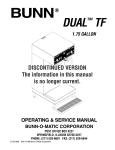

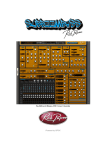
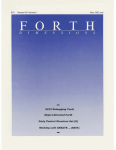


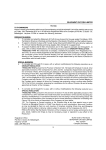

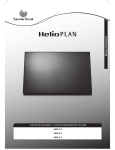
![10780-90006 - 10780A Laser Receiver for 5501A [Prefix 1948] (Mar](http://vs1.manualzilla.com/store/data/006009643_1-6e2f54ebb2199ef6df634558ba4c1bb6-150x150.png)
